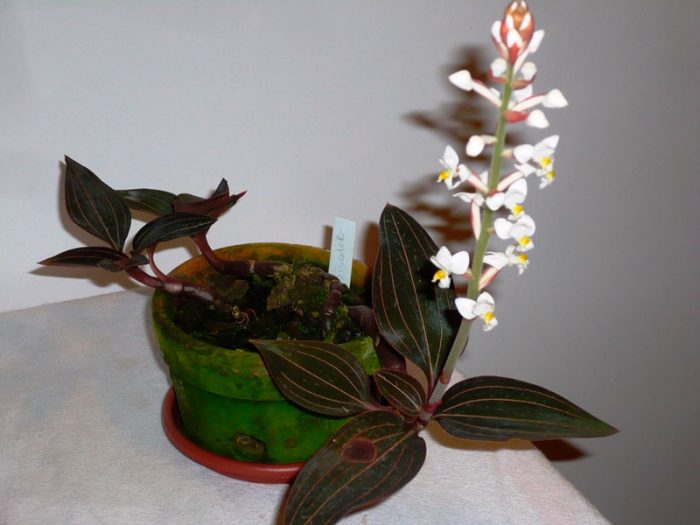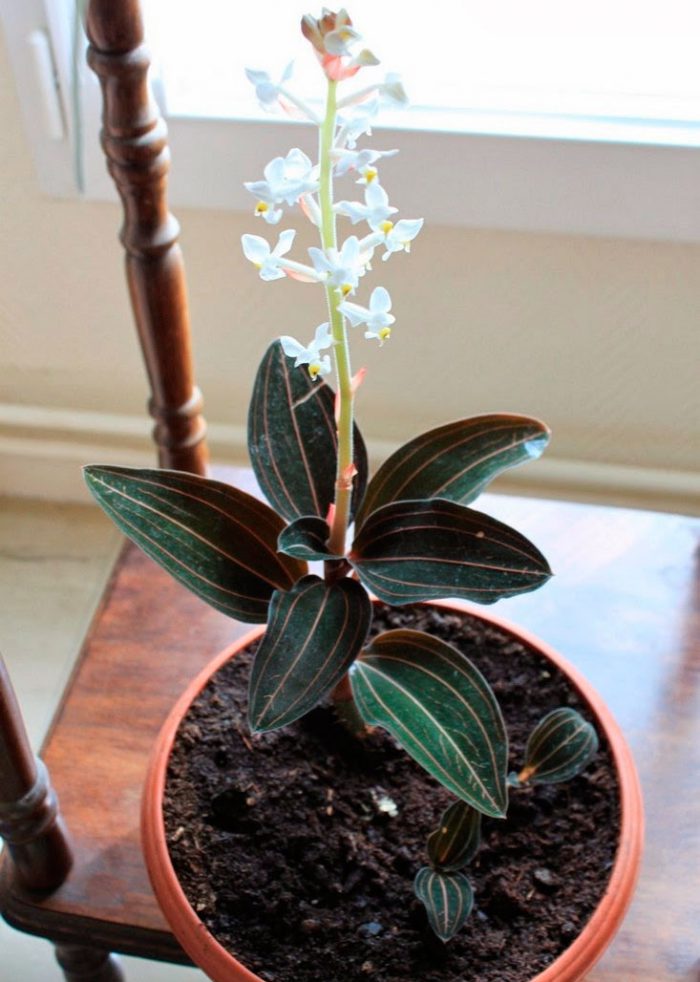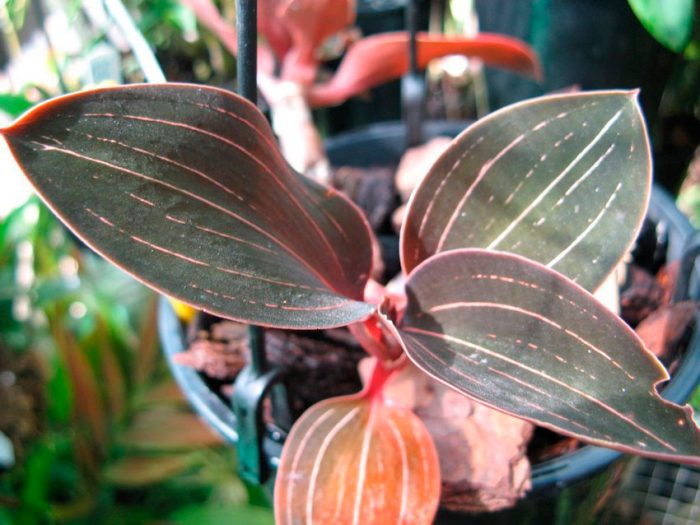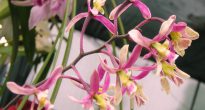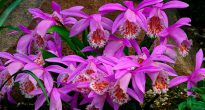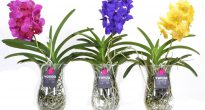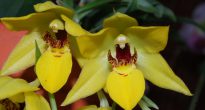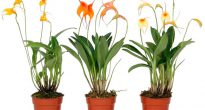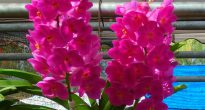An orchid like ludisia discolor (Ludisia discolor) is related to the monotypic genus of the orchid family and at the same time is its only representative. This plant in natural conditions can be found in tropical rain forests of the continental part of Southeast Asia, as well as Sumatra.
Ludisia is also called hemaria. This terrestrial orchid is herbaceous. Its creeping shoots, branching and fleshy, are located on the surface of the soil. From them, many young stems extend upward, which reach about 15 centimeters in height. The successive leaves are vaginal or planted on a wide and flat vaginal petiole. Simple leaves have a broad-lanceolate shape and reach a length of 7 centimeters, and in width - from 3 to 4 centimeters. The “sparkling”, velvety front side is painted in a rich color shade, which can be from greenish-burgundy to almost black or emerald. There are clearly visible veins on the leaf plate, which are located parallel to the central one, but in the original species they are difficult to see. The seamy part of the leaves is smooth and colored in a burgundy-brownish color. The stem and petiole are painted in the same color shade. Each leaf plate lives for about 7 years, and then it withers and dies off, while a ring-shaped "notch" remains on the stem, which is painted in a lighter color.
Experienced orchidists refer such a plant to a group called "precious orchids". It is appreciated not for flowers, but for the spectacular appearance of foliage, which has a unique texture, as well as unusual colors. This plant blooms, as a rule, in the late autumn and early winter period. A fairly tall (up to 25 centimeters) peduncle grows from the upper part of the stem and it bears a multi-flowered raceme with very small (about 2 centimeters in diameter) flowers. The flowers themselves are painted white, and their anthers are yellow. If environmental conditions are favorable, then flowering will last more than 1 month.
Content
Ludisia orchid care at home
Unlike other representatives of the extensive orchid family, ludisias do not require any special growing conditions. However, most flower growers noticed the sudden death of the plant for completely unclear reasons.In this regard, in order to try to avoid the sudden death of this kind of orchid, you need to try to properly care for it as much as possible.
Temperature regime
Ludisia growing in natural conditions is able to withstand temperatures of 10-37 degrees. However, it is better to protect a flower growing at home from such a rather extreme temperature regime. So, experts advise in the summer during the day to maintain the temperature at the level of 20 to 29 degrees, while at night it should be 3-5 degrees less. This plant needs a difference in daily temperatures, since it is a prerequisite for laying flower buds. In winter, it is recommended to keep the flower cool (about 18 degrees), then its flowering will be longer.
Illumination
This kind of orchid is shade-loving, so it should not be placed in places with bright lighting. For its placement, it is recommended to prefer western or northern windows. And ludisia can also be placed in the back of the room, but in this case it will need to be highlighted with special phytolamps. Daylight hours are quite long and should be from 12 to 14 hours. Also, the plant needs lighting in winter, when daylight hours become much shorter than normal.
How to water
This flower reacts negatively to dryness. In this regard, the substrate must always be slightly damp. However, the liquid should also not stagnate in the pot, as this will cause rotting of the ludisia.
For watering, you need to use well-settled soft water, which must be at room temperature. Watering is recommended by completely immersing the container in water, which should be obtained after a few minutes.
Humidity
The plant thrives best in high humidity (about 70 percent). However, you cannot increase humidity by spraying the foliage. The fact is that dried water droplets leave ugly marks on the velvety leaves, which are almost impossible to get rid of. For this purpose, it is recommended to place an open container filled with water in the immediate vicinity of the flower, and pour wet expanded clay into the pan. It is worth remembering that such a plant should not be placed near heating appliances. The fact is that streams of hot, dry air can cause the tips of the leaves to dry out, and this will greatly spoil the appearance of ludisia.
Pruning
Formative pruning of this genus is completely unnecessary for the orchid, because its short stems do not branch.
Earth mix
A suitable soil should be loose, have neutral acidity, and be water and air permeable. There are several options for compositions suitable for planting this plant of soil mixtures:
- Fine-grained pieces of pine bark, half-decomposed foliage and high moor peat (1: 1: 2).
- High-moor peat, sphagnum, chopped roots of the osmund fern, coarse river sand, taken in equal proportions.
- Sphagnum, pine needles, high moor peat, leaf soil, birch charcoal, polystyrene foam (4: 4: 4: 4: 1: 1).
For planting, choose wide, low containers, while you should not forget to make a good drainage layer (foam or expanded clay is suitable). At the end of planting, a layer of moss is laid out on top of the substrate, which must be systematically moistened so that it does not dry out.
Fertilizer
Top dressing is carried out during intensive growth once every 2 weeks. To do this, use a special fertilizer for orchids. The rest of the time (including winter), fertilizer should be applied to the substrate once every 4 weeks.
Transplant features
The transplant is carried out 1 time in 2 or 3 years in the spring. As a rule, by this time ludisia grows and it becomes cramped in an old pot.
Reproduction methods
When grown indoors, it can be propagated by division.It should be remembered that the part separated from the rooted aerial stem in an adult plant must have at least three shoots.
Pests and diseases
As a rule, such an orchid is sick due to improper care. So, as a result of constant stagnation of water in the substrate, rot is formed on the root system and creeping shoots. Due to too intense lighting, burns form on the leaves, and the flower itself begins to fade.
The plant is most often settled spider mite... Favorable conditions for it are: warm and low air humidity.
Video review
Main varieties
Thanks to breeders, not only a species plant was born, but also several varieties of Ludisia. They differ from each other in the color of their foliage. The most popular varieties are:
Alba
A distinctive feature of this variety is the absence of red pigment in the foliage. As a result, his leaves are painted in a rich green color. On the leaf blade itself, there are clearly visible small lateral veins and a large central vein, since they are painted in a contrasting color shade.
Odina
The front side of the foliage is painted in a very dark, almost greenish-black color. On their surface, longitudinal colored with a lighter color shade, as well as small lateral veins, which diverge from the central vein, are clearly distinguishable.
Dawsoniana
Its greenish-black leaves with a burgundy tint are relatively large. Pale red longitudinal veins are clearly visible on the leaf surface.
Otletae
In this variety, the greenish-black leaf plate has a narrow-lanceolate shape, while longitudinal veins of a pale red color are clearly visible on its surface.
There are a couple more varieties of this plant that have a very unusual appearance - these are Rubrovenia and the larger Trilineata. Elliptical leaves are painted in a bronze color, while their veins are copper.

